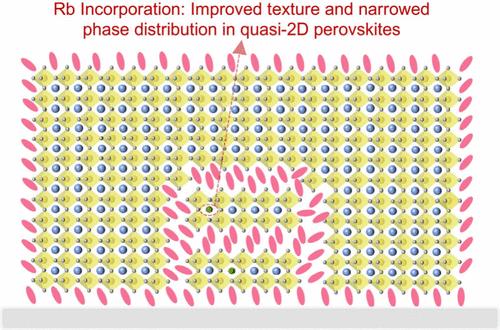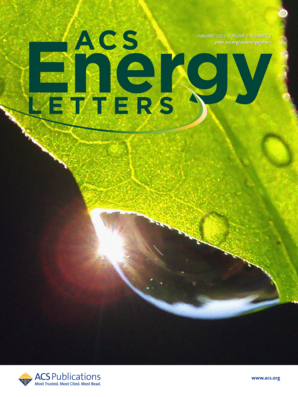Rubidium Induced Phase Regulation for High-Performance Quasi-2D Perovskite Solar Cells
IF 19.3
1区 材料科学
Q1 CHEMISTRY, PHYSICAL
引用次数: 0
Abstract
Quasi-two-dimensional (2D) perovskites are notable for their diverse formulations and environmental stability. However, solution-processed quasi-2D perovskites often exhibit inherent multiple-quantum-well structures with broad phase distributions, limiting their efficiency in photovoltaic applications. Here, we demonstrate that incorporating rubidium ions effectively narrows the phase distribution in quasi-2D perovskite by accelerating the formation of the n = 1 2D perovskite phase during the initial crystallization stage. This leads to a decrease in the remaining free organic spacer cations, which in turn limits the transition to medium-n phases (n = 3, 4) and promotes the formation of high-quality 3D-like or large-n perovskites, ultimately enhancing charge transport of quasi-2D perovskite. Consequently, we achieve quasi-2D perovskite solar cells with a champion power conversion efficiency of 21.9%. Furthermore, the thermal stability of the unencapsulated devices containing rubidium is significantly improved, with the T80 lifetime under continuous 60 °C stress increasing from 1150 to over 3000 h.

用于高性能准二维过氧化物太阳能电池的铷诱导相位调节技术
准二维(2D)过氧化物因其多样化的配方和环境稳定性而备受瞩目。然而,溶液加工的准二维过氧化物晶石往往表现出固有的多量子阱结构和宽泛的相分布,从而限制了其在光伏应用中的效率。在此,我们证明了掺入铷离子可在结晶初始阶段加速 n = 1 二维包晶相的形成,从而有效缩小准二维包晶的相分布。这导致剩余的游离有机间隔阳离子减少,进而限制了向中n相(n = 3、4)的过渡,促进了高质量类三维或大n包晶的形成,最终增强了准二维包晶的电荷传输。因此,我们实现了功率转换效率高达 21.9% 的准二维包晶太阳能电池。此外,含有铷的未封装器件的热稳定性也得到了显著提高,在 60°C 持续应力下的 T80 寿命从 1150 小时延长到 3000 小时以上。
本文章由计算机程序翻译,如有差异,请以英文原文为准。
求助全文
约1分钟内获得全文
求助全文
来源期刊

ACS Energy Letters
Energy-Renewable Energy, Sustainability and the Environment
CiteScore
31.20
自引率
5.00%
发文量
469
审稿时长
1 months
期刊介绍:
ACS Energy Letters is a monthly journal that publishes papers reporting new scientific advances in energy research. The journal focuses on topics that are of interest to scientists working in the fundamental and applied sciences. Rapid publication is a central criterion for acceptance, and the journal is known for its quick publication times, with an average of 4-6 weeks from submission to web publication in As Soon As Publishable format.
ACS Energy Letters is ranked as the number one journal in the Web of Science Electrochemistry category. It also ranks within the top 10 journals for Physical Chemistry, Energy & Fuels, and Nanoscience & Nanotechnology.
The journal offers several types of articles, including Letters, Energy Express, Perspectives, Reviews, Editorials, Viewpoints and Energy Focus. Additionally, authors have the option to submit videos that summarize or support the information presented in a Perspective or Review article, which can be highlighted on the journal's website. ACS Energy Letters is abstracted and indexed in Chemical Abstracts Service/SciFinder, EBSCO-summon, PubMed, Web of Science, Scopus and Portico.
 求助内容:
求助内容: 应助结果提醒方式:
应助结果提醒方式:


